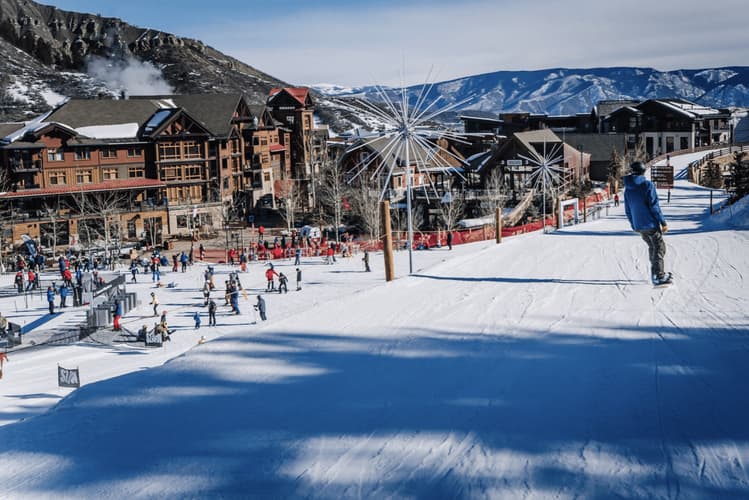Aspen Mountain offers steep terrain and dramatic granite faces just above Aspen, with quick access to the town’s shops and restaurants.
Geography
| Continent | North America |
|---|---|
| Region | Colorado |
| Subregion | Mountain West |
| Country | United States |
| State | Colorado |
| County | Pitkin |
| District | Aspen |
| City | Aspen |
| Postal Code | 81611 |
| Timezone | AmericaDenver |
| Latitude | 39.17 |
| Longitude | -106.83 |
| Maps |
Aspen Mountain rises just above the town of Aspen, offering dramatic granite rises and compact, steep terrains known for challenging black runs and expansive views. The base sits within walking distance of downtown Aspen’s shops, eateries, and the historic silver-mining heritage that colors the town’s vibe. In winter, the slopes are served by efficient lifts that thread between pine and granite, while summer reveals hiking and scenic ridges above the town. The mountain’s long-running ski culture makes it a centerpiece of the Aspen Snowmass experience, rewarding confident skiers and adventurous visitors alike.
Useful Products
We think these products might be useful on your journey!
Category: Gear
Price: $40 – $160
Anti-fog goggles built for alpine conditions. They help you keep clear vision on Aspen Mountain from first chair to last run. Essential for visibility and eye protection on cold, windy days.
Category: Clothing
Price: $80 – $300
Waterproof, windproof, and breathable to handle changing mountain weather. Keeps you warm on Aspen Mountain. Ideal for comfort, dryness, and style.
Category: Clothing
Price: $40 – $120
Soft, breathable base layer that regulates temperature on cold chairlifts and descents. Great for moisture management and all-day warmth on Aspen Mountain.
Category: Clothing
Price: $15 – $60
Thick yet breathable socks for warmth and blister prevention. Adds comfort during all-day skiing on Aspen Mountain. Great for moisture control.
Category: Gear
Price: $25 – $120
Windproof, insulated gloves to keep fingers warm on chilly lifts and powder days. Perfect for grip, dexterity, and warmth.
Category: Gear
Price: $40 – $150
Lightweight helmet with impact protection and adjustable fit. A must for safety on Aspen Mountain.
Category: Gear
Price: $15 – $50
Compact bag for transporting boots and gear between rides or flights. Keeps your kit organized and easy to carry.
Category: Skincare
Price: $5 – $20
Water-resistant protection for exposed skin during sunny alpine days. Critical for skin protection at high altitude on Aspen Mountain.
Category: Skincare
Price: $3 – $10
Protects lips from drying wind on cold chair rides. Simple, portable, and great for lip care during long days.
Category: Accessories
Price: $30 – $100
Lightweight hydration pack to stay hydrated on the mountain. Convenient reliable hydration during sun or powder. Great for Aspen Mountain endurance.
Category: Accessories
Price: $15 – $40
Protects from sun on ridges and summits when off the slopes. Adds cool shade and style during summer visits.
Category: Electronics
Price: $30 – $180
Stabilizes your footage for smooth memories on winter or summer adventures. Useful for steady video on Aspen Mountain.
Category: Electronics
Price: $25 – $60
Power on the go to keep phones, cameras, and GPS charged all day. Essential for backup power during mountain trips.
Category: Electronics
Price: $15 – $60
Bright hands-free lighting for dusk runs or après-ski tasks. Keeps you visible and safe at night on mountain trails.
Category: Accessories
Price: $8 – $25
Warm, breathable neck protection against wind chill. Ideal for layering on cold days.
Category: Maintenance
Price: $8 – $40
Keeps edges smooth and skis gliding on varying snow. Great for tuning and improving performance on Aspen Mountain.
Category: Hydration
Price: $15 – $40
Keeps drinks hot or cold when you're out on a long day on the mountain. Durable hydration companion for adventures at Aspen Mountain.
All content was written by our AI and may contain a few mistakes. We may earn commissions on some links. Last updated: Mon Nov 24, 2025, 7:01 PM





